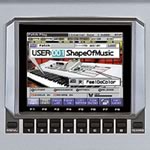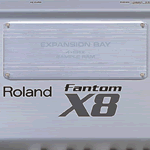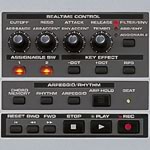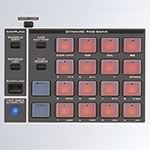Introducing the Roland Fantom X8

This is the first of a series of articles covering Roland’s flagship synthesizer workstation the Fantom X series (which includes the X6, X7 and X8 in addition to a rack-mountable version of the synth). In particular I will be referring to the behemoth cream of the Fantom crop; the X8.
The Roland Fantom X8 is a 30kg behemoth forged from brushed aluminum, thick aluminum ends and built upon a solid base of fiber-board. It is, perhaps, the most impressively robust looking workstation in its class to the point where you don’t worry about damaging it on the move but rather what it might damage if not handled carefully.

The Roland Fantom X includes 128 voices of polyphony, 1,436 standard waveforms to get you started with sound design, 1,024 onboard preset patches plus 256 General MIDI 2, 40 preset rhythm sets plus 9 General MIDI 2 and 64 preset performances. Onboard user memory allows for 256 patches, 32 rhythm sets and 64 performances with an additional 256, 32 and 64 available on any storage card you insert. 3 multi-effects systems are available with 78 effect types, 3 chorus types and 5 reverb types. The audio input has 6 effect types including a compressor any one of which can be used in addition to the multi-effects to produced compressed, reverb vocals for example. The most striking element of all the Fantom X range could well be the colour LCD, although it was a first on the Fantom X it’s now fast becomming the norm in synths and workstations alike. Alas the Fantom X LCD is not touch screeen.
Unlike its smaller brothers the Fantom X6 and Fantom X7 the Roland Fantom X8 boasts 88 progressive hammer action keys that make it close enough to a piano for all but the most discerning pianist to be comfortable with. This, combined with the standard “Ultimate Grand” piano patch available on all Roland Fantom X models, makes it one of the best out-of-box synthesizers for authentic sounding and expressive piano. In fact it’s this combination that won me over. As I rarely, if ever, play a real piano I find the Fantom X8 to be an absolute joy to play both tactually and audibly. In addition to the onboard “Ultimate Grand” there are many varied acoustic and electric pianos to suit a wide range of musical styles, and if that isn’t enough for you there are third party piano patches such as William Coakley’s “Perfect Piano” and the first party SRX-07 “Ultimate Keys” or SRX-11 “Complete Piano” SRX expansions from Roland.

SRX expansions such as “Ultimate Keys” offer a wide variety of expansion options to the Roland Fantom’s onboard patches; instead of having to load samples into the active memory when needed (and this is a slow process on the Fantom X) the patches on SRX expansion boards are just “there” and are as good as built in from the moment you place them into the expansion bay. The Fantom X8 boasts 4 such SRX expansions which is too few for some and too many for others, with one of Roland’s current promotional boards (Jon Lord’s Rock Organs or Analogue Essentials) occupying an SRX slot you might not find the room for the much larger retail expansions. When you consider that the Fantom XR (the rack version of the Fantom) has 6 expansion slots the 4 in the Fantom is somewhat disappointing, however if you can afford to fill those slots and actually need to produce that great a variety of sound then the Fantom XR and the Fantom X8 are a powerful combination that will double up your polyphony and sampling capabilities in addition to providing a second sequencer and 3 multi-effects processors which you can route parts from either the Roland Fantom XR or the Roland Fantom X8 through. I’ve almost convinced myself I need a Fantom XR now!
In addition to its progressive hammer action, the key-bed of the Fantom X8 offers after-touch. Whereas velocity measures the force you apply when pressing down a key, usually to control the loudness of the note played, after-touch applies additional expression to sounds based on how hard you press on a key after it has been depressed and triggered its sound. After-touch is fantastically fun when combined with synth patches and, when combined with the Fantom’s other controllers, allows for some incredible dynamic variations of sound outside of the classic Cutoff and Resonance jockeying.
The Roland Fantom X8 has, of course, the fairly standard hold and control pedal support and should never be bought without an accompanying Roland EV-5 and DP-10. Alas there are no other inputs for other non-midi control pedals but if you’re big on pedals then a MIDI Pedal Board will not only give you more control but If you’re fast enough on your feet you can even play drum or bass lines. Using a couple of the 16 layers in a Fantom X performance you can place each note, crash or hit in a comfortable to play order and pull off some amazingly tricky looking feats.

As one would expect the Fantom X8 also has an array of realtime control knobs which can either be used to control Cutoff, Resonance, Attack and Release or Arpeggio Range, Arpeggio Accent, Rhythm Accent and Tempo. This leads me to my first issue with the Fantom X, the X8 in particular is absolutely brimming with space on the upper surface for controllers yet only 4 knobs are available and shared between 8 functions. The second, and more important to me, issue is the complete lack of volume sliders or any sort of real-time hardware mixer on the Fantom X. Of course you can use the colour screen, screen buttons, and the 4 control knobs to adjust the volume of parts but I really can’t bear to think how much fun I could be having with even 8 simultaneous synth patches and 8 volume sliders to change the way they blend and sound. This is a feature I enjoy on the Roland V-Synth GT which supports an upper and lower tone with hardware knobs to adjust the volume of each. If there’s anything the Fantom X needs (apart from USB host support) it’s more realtime controllers and mixing sliders with on/off buttons for at least 8 of its 16 part performances; these could be used with the sequencer MIDI and audio tracks too.
Roland’s D-Beam is present on the Roland Fantom X, albeit only one of them. This is an infra-red proximity sensor which you can wave your hand over to adjust any assigned MIDI parameter or even use the D-Beam as a solo synthesizer. There’s also the pretty standard pitch/modulation lever and two assignable switches.
Lack of USB host support, as you might have guessed, is my second biggest gripe with the Fantom X. Of course, loading and saving samples takes such a significant amount of time that using a large external hard disk to store thousands of them would be almost useless but being able to use a hot-pluggable USB thumb drive instead of an odd combination of PCMCIA and SD cards would be much better for isolating performances/compositions onto their own storage medium so that they can’t be accidentally over-written.

Enough of the bad, for now at least, another of the features that drew me to the Fantom X is the very impressive looking array of 16, back-lit trigger pads which can be assigned to a variety of different functions that expands dramatically depending on your familiarity with MIDI SysEx commands. The most basic function of the trigger pads and the one they’ll default to is a drum kit, each of the 16 pads is velocity sensitive so with a bit of practice you can be re-sampling live hand rolled drum loops and never have to fuss about programming rhythms. After playing the drums to the metronome for a minute or so you can chop your sample up into loops and assign them to the pads. You can even play a bass line over your drum loops and re-sample the resulting drums and bass onto a pad, add some looped strings or melodies to this and you’ve built up a performance without even touching the sequencer- all you have to do is play your lead over the top and tap a new pad to change your backing.
The time has come to draw this introduction to a close, I’ve said more than I intended and will bring you articles on specific areas including the sequencer, arpeggios and rhythm system of the Fantom over the coming weeks.
Due to the size, weight and cost of the Fantom X8, if you’re looking into picking one up you’re better dealing with a local store than online. Taking in the lowest online price you can find at Sound Control, Digital Village or Andertons might get the highstreet price down as these are both also brick and mortar stores. Of course if the lowest price is from a store near you, you’re sorted! If you’re looking for a local high-street retailer (which you should be for a product like this) I personally recommend SoundControl although this recommendation is based only on my experiences in my local (Norwich) store.
As a final word; when buying a Roland Fantom X8 second hand look out for “Audio Track Expansion” under the expansion bay or confirm otherwise that the unit has been upgraded. The Audio Track Expansion includes:
- Eight linear stereo audio tracks.
- Tracks can be played back from any point in the song, and can be synchronized with the MIDI tracks via realtime time-stretching.
- Multisample waveform editor for serious sample-based patch creation.
- Auto-Patch Bank mode creates patches for every sample for quick use in compositions.
- New Sample Gain parameter (0/+6/+12dB)
Also, don’t forget to grab a copy of the Fantom X Tweakbook from Sinevibes.